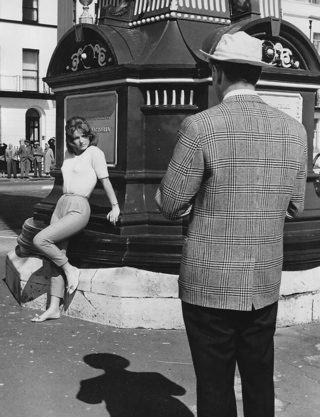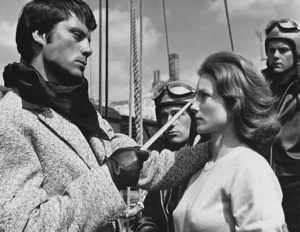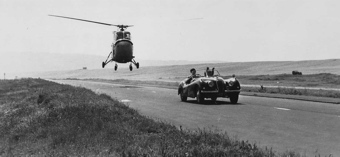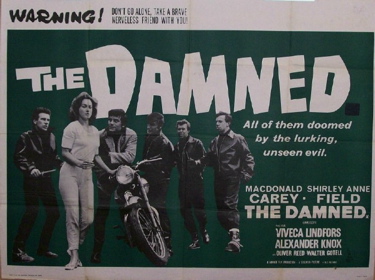| Release List | Reviews | Price Search | Shop | Newsletter | Forum | DVD Giveaways | Blu-Ray/ HD DVD | Advertise |
| Reviews & Columns |
|
Reviews DVD TV on DVD Blu-ray International DVDs Theatrical Reviews by Studio Video Games Features Collector Series DVDs Easter Egg Database Interviews DVD Talk TV DVD Talk Radio Feature Articles Columns Anime Talk DVD Savant HD Talk Horror DVDs Silent DVD
|
DVD Talk Forum |
|
|
| Resources |
|
DVD Price Search Customer Service #'s RCE Info Links |
|
Columns
|
 |
"These Are THE DAMNED" |

|
"These Are THE DAMNED" Not on R1 DVD 1961 / B&W / 2:35 anamorphic widescreen / 77, 87, 96 min. / Possible R2 and R1 releases soon (as of August, 2007) Starring Macdonald Carey, Shirley Anne Field, Oliver Reed, Viveca Lindfors, Alexander Knox, Walter Gotell, James Villiers, Kenneth Cope Cinematography Arthur Grant Production Design Bernard Robinson Art Direction Don Mingaye Film Editor Reginald Mills Original Music James Bernard Written by Evan Jones from the story The Children of Light by H.L. Lawrence Produced by Anthony Hinds Directed by Joseph Losey |
Note: This short piece originally ran on the Turner Classic Movies website in July 2007, to accompany the TCM premiere of the film in a short series called "Radiation Damage." I repeat it here as I have notes on Mothra, to promote a Region 1 DVD release.
Note, 3/23/10: It has been released at last;
Savant's review is at this link.

In 1950s Sci-Fi, runaway radiation created monsters, raised the dead and turned people into midgets and giants, effects that only alluded to real-life nuclear dangers. In 1961, blacklisted American director Joseph Losey struck much closer to the truth with this chilling fantasy from Hammer films. Its release in England was unaccountably delayed for over two years, and when it finally reached American screens in 1965, even Variety openly suspected that it had been suppressed. "These Are THE DAMNED" (original English title, "THE DAMNED") is a radical thriller about artists and bureaucrats, juvenile delinquency and sinister top secret government projects. Its source is a book by H.L Lawrence, The Children of Light.
The movie is a catalogue of ideas that would inflame guardians of England's public image. A seaside town is depicted as overrun by a pack of unruly Teddy Boys, biker hoodlums led by King (Oliver Reed), a sullen thug with incestuous designs on his sister Joan (Shirley Anne Field). The gang uses Joan as bait to mug Simon, an American tourist disenchanted with modern life (MacDonald Carey). Simon meets the bohemian artist Freya (Viveca Lindfors, in her best role), a free-spirit sculptress of subversive statues resembling the charred remains of Hiroshima victims. Freya is in turn the mistress of Bernard (Alexander Knox), a stuffy executive in charge of an ultra top-secret military experiment. It is so secret, Bernard says, that should he tell Freya about it he "might be condemning her to death."

Simon defies King's gang and escapes on his boat with Joan, who seeks to break free of her brother's control. King pursues them near Bernard's secret project, a heavily-guarded compound reminiscent of Hammer's earlier Quatermass films. Simon, King and Joan soon find themselves in a futuristic bunker hidden below the sea cliffs, with a group of imprisoned children. The focus of Bernard's experiment, the sheltered and polite children wear tidy school uniforms and are being raised by remote control. The only contact with their 'keepers' is through a television screen, from which Bernard condescendingly promises that their many questions about life and the world will be answered, "When the time comes." The children are a mystery to Simon until Joan discovers that their body temperature is "ice cold." Bernard is rearing a breed of radioactive people to continue the human race in a post-nuclear radioactive world.

These Are the Damned takes a shockingly anti-establishment view of the nuclear arms race. Bernard justifies his atrocious experiment with the conviction that nuclear annihilation is inevitable. Freya goads him with loaded libertarian questions: Why is a public servant permitted to have secrets from his master, the public? She knows that Bernard is up to no good in his secret lab but also worships oblivion in her own way, through her morbid statues. Screenwriter Evan Jones is quick to choose sides; as in Anthony Burgess' A Clockwork Orange the hooligan motorcycle gang is simply a mirror image of the institutionalized brutality of society at large. The Teddy Boys' outlaw disenchantment is a direct reaction to the warped values of the adult generation. As Bernard puts it, "The age of senseless violence has caught up with us too." James Bernard's Teddy Boy theme Black Leather Rock is an anthem for a new era of anarchy.

Joseph Losey's prowling HammerScope camera uses landscape to heighten his dramatic contrasts. The sleepy holiday town gives way to the barren cliffs of Weymouth. The concrete and steel warrens of Bernard's inhuman project lie just below Freya's cliff-side studio, implying a direct relationship between political art and society's hidden agendas. The violent climax sees huge helicopters pursuing King's sports car down the seaside highway like ominous Orwellian watchdogs.
Viewers are apt to find an even stronger image burned into their memory when the bunker doors open and the children stumble out into the light. As a rubber-suited goon threatens, Joan introduces one of the liberated children to the joys of a tiny flower. It's a perfect visual expression of the later pacifist motto, "War is Not Healthy for Children and Other Living Things." Freya and Simon should be running for their lives instead of confronting Bernard with the obscene truth of his atrocious project -- the 'graveyard bird' helicopters are already closing in for the kill.

These Are the Damned was cut by nineteen minutes for one version, removing many of its sharp philosophical speeches and a handful of interesting character confrontations. An encounter between Freya and King was cut in half, inadvertently making it look as if a rape occurs. Losey reportedly objected when the studio insisted that the Bernard character personally commit one of the final murders, as the director's plan was to assign that role to the faceless helicopters. If released in a timely fashion These Are the Damned might have been a key film of the Ban the Bomb years. It was instead shelved, cut up and discarded for reasons that were never made clear.

Sony/Columbia restored the film to its original 96-minute length in the early 1990s, and it has been greeted with enthusiasm at film festivals ever since. What was once considered one of Joseph Losey's weakest efforts is quickly becoming recognized as the very best of English Science Fiction filmmaking.
Reviewed: July 4, 2007
Let's hope it's on DVD soon!
Reviews on the Savant main site have additional credits information and are more likely to be updated and annotated with reader input and graphics.
Review Staff | About DVD Talk | Newsletter Subscribe | Join DVD Talk Forum
Copyright © MH Sub I, LLC dba Internet Brands. | Privacy Policy | Terms of Use
|
| Release List | Reviews | Price Search | Shop | SUBSCRIBE | Forum | DVD Giveaways | Blu-Ray/ HD DVD | Advertise |





